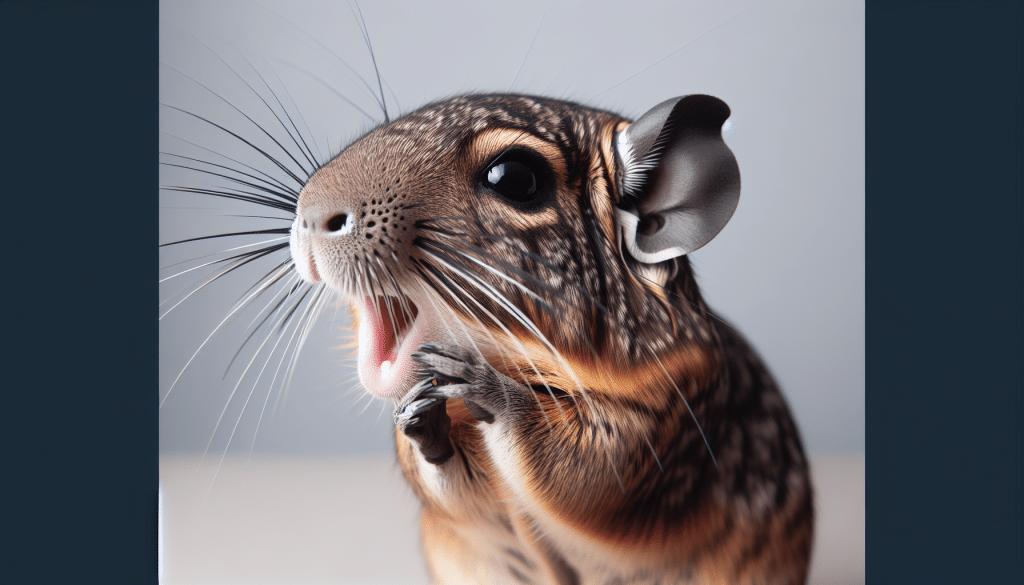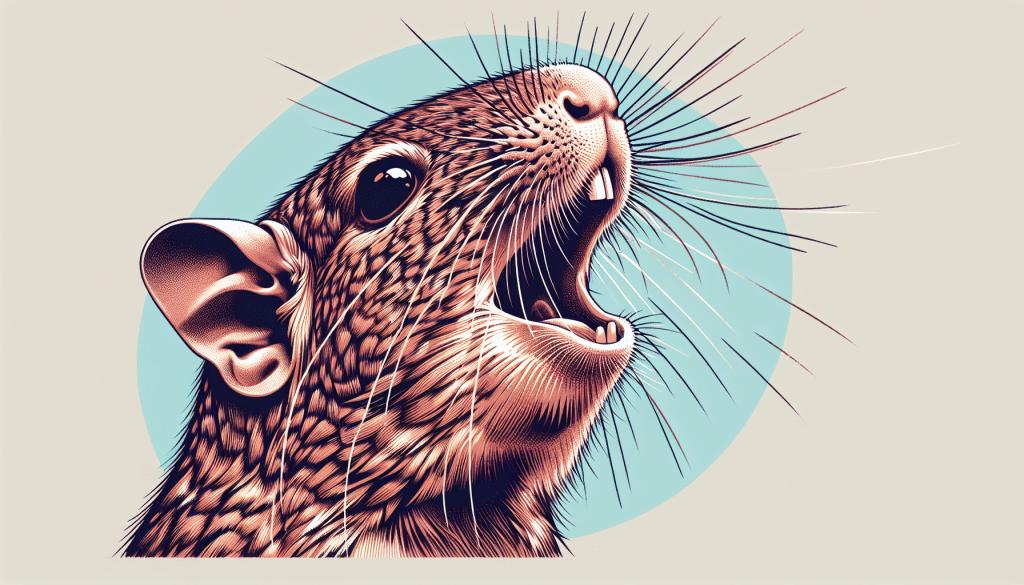In this article, you will learn how to understand the way degus talk to each other. Degus are little furry animals that make different sounds to communicate with their friends and family. By decoding their vocalization patterns, we can discover what they are saying and better understand what they need. So, get ready to explore the wonderful world of degu communication and learn to speak their language!

The Basics of Degu Communication
Understanding the social nature of degus
Degus are social creatures that live in family groups called colonies. They rely on communication to interact with one another and understand their surroundings.
Primary methods of degu communication
Degus primarily communicate through both vocal and non-vocal cues. Vocal communication involves making sounds, while non-vocal communication includes body language, scent-marking, and grooming.
Comparing vocal and non-vocal cues
Vocal cues involve the sounds degus make, such as chirping, barking, or chattering. Non-vocal cues, on the other hand, refer to the body movements, postures, and scents degus use to express themselves.
Decoding the Vocals: Types of Degu Sounds
Frequency and pitch variation
Degus have a wide range of sounds, and the frequency and pitch of their calls can vary. This variation allows them to convey different meanings and emotions.
Duration of calls and their meanings
The duration of degu calls can also provide important information. Short, quick calls may signal alarm or danger, while longer calls can indicate playfulness, contentment, or mating behavior.
Context-specific vocalizations
Degus use different vocalizations depending on the context. For example, they have specific calls to communicate with their family group, mating calls to attract a mate, and alerting calls to warn others of potential threats.

The Social Context of Vocalization
Communication within the family group
Vocalization plays a crucial role in communication within the degu family group. Members use various sounds to maintain social bonds, indicate dominance or submission, and express their needs.
Vocalizations in mating rituals
During mating rituals, degus produce unique vocalizations to attract potential mates. These calls are often long and melodious, signaling their availability and readiness to mate.
Alerting and warning calls
Degus have specific vocalizations to alert and warn their colony members of approaching predators or other dangers. These calls help the group stay safe and coordinated.
Significance of vocal communication in territorial behavior
Vocal communication is essential in defining and defending territories. Degus use their calls to establish ownership, warn intruders, and maintain boundaries with neighboring colonies.
Development of Vocal Communication in Juveniles
Learning vocalizations from parents
Young degus learn vocalizations by imitating their parents and older colony members. They listen and practice to develop their communication skills over time.
Play and experimentation with sounds
Juvenile degus often engage in play and experimentation with sounds. They produce various vocalizations and observe the responses of other colony members, refining their vocal communication skills through these interactions.
The role of vocal learning in social integration
Vocal learning is crucial for young degus to integrate into their family group and communicate effectively. By learning and adapting to the vocal patterns of their colony, they can establish social connections and contribute to the group’s cohesion.

Analyzing Vocal Patterns: Techniques and Tools
Recording and analyzing sound frequency
To analyze degu vocal patterns, researchers use specialized recording equipment to capture their sounds. They then examine the frequency of these sounds to identify patterns and understand their meaning.
Utilizing spectrograms for pattern identification
Spectrograms, visual representations of sound frequency over time, are useful tools for analyzing degu vocalizations. They allow researchers to identify specific patterns and correlations between vocalizations and behavior.
Correlating vocal patterns with behavior
By studying degu vocalizations in conjunction with their behavior, researchers can identify meaningful correlations. This helps them understand how different vocal patterns relate to specific actions, emotions, or intentions.
Non-Vocal Communication in Degus
Body language and its role
In addition to vocalizations, degus communicate through body language. They use various postures, movements, and gestures to convey their emotions, intentions, and social status.
The use of scent-marking
Degus have scent glands that they use to mark their territory and communicate with others. They leave scent trails to indicate ownership, attract mates, and convey information about their identity.
Grooming as a form of communication
Grooming is an important non-vocal form of communication in degus. It helps them maintain social bonds, express trust, and establish hierarchy within the family group.
Comparison between vocal and non-vocal interactions
Both vocal and non-vocal communication are crucial for degus to effectively convey their messages. While vocalizations may be more immediately noticeable, non-vocal interactions provide additional layers of information and nuance.
Influences on Degu Vocalization
Effect of environmental factors on vocalization
Environmental factors, such as the presence of predators, availability of resources, and social dynamics within the colony, can influence degu vocalizations. These factors shape the content and frequency of their vocal communication.
Impact of stress and wellbeing
The emotional state of degus, including stress and overall wellbeing, can impact their vocalization patterns. Stressed or unhealthy degus may exhibit changes in their vocal repertoire, volume, or duration of vocalizations.
Variation in vocal communication across different degu populations
Different populations of degus may exhibit variations in their vocal communication patterns. Factors such as geographical location, genetic differences, and unique social structures can contribute to these variations.
Human Interpretation and Interaction
Understanding behavioral cues for better care
For pet owners, understanding degu behavioral cues is essential for providing appropriate care and addressing their needs. Recognizing signs of distress, contentment, and social interactions can help ensure their wellbeing.
Training and modifying degu vocal behavior
While degus have natural vocalization patterns, some owners may wish to modify or train their degus’ vocal behaviors. Positive reinforcement and reward-based methods can be used to encourage desired vocalizations or discourage excessive or undesirable vocalizations.
Challenges in interpreting degu communications
Interpreting degu communications can be challenging, as their vocalizations and non-vocal cues may have subtle variations and context-specific meanings. Observing their behavior, seeking professional advice, and learning from experienced owners can help overcome these challenges.
Vocalizations and Degu Health
Vocal changes as indicators of health issues
Changes in degu vocalizations can indicate potential health issues. A sudden change in pitch, frequency, or duration of vocalizations may suggest pain, discomfort, or illness. Monitoring vocal patterns can help detect health problems early.
Silence and its implications for welfare
Silence in degus can also have implications for their welfare. A complete lack of vocalizations may indicate stress, depression, or social isolation. It is important for owners to monitor vocal activity and ensure their degus have a healthy social environment.
Monitoring vocalizations for early detection of distress
Regularly monitoring degus’ vocalizations allows pet owners to catch early signs of distress or discomfort. Recognizing abnormal vocal patterns can prompt timely intervention and veterinary care if necessary.
Practical Applications for Pet Owners
Behavioral enrichment based on vocal communication
Understanding degu vocalizations allows pet owners to provide behavioral enrichment. Playing sounds that mimic natural vocalizations in the wild or engaging in interactive play can help satisfy degus’ communication needs.
Improving degu well-being through voice recognition
Developing voice recognition technology for degus can contribute to their well-being. Being able to identify specific vocalizations, such as distress calls or mating calls, can help owners understand their degus’ needs and provide appropriate care.
Community building: Sharing knowledge with other degu owners
Sharing knowledge and experiences with other degu owners is an important way to build a community. By exchanging information about degu vocalizations and communication, owners can support one another in providing the best care for their pets.
In conclusion, degus communicate through vocal and non-vocal cues, using a variety of sounds, body language, scent-marking, and grooming. Understanding their communication patterns and context-specific vocalizations is essential for maintaining their well-being and providing appropriate care. Monitoring vocalizations and recognizing changes can help detect potential health issues early on. By applying knowledge about degu communication in practical ways, pet owners can enhance their degus’ quality of life and strengthen the bond between human and pet.
